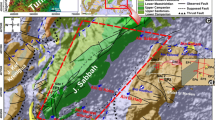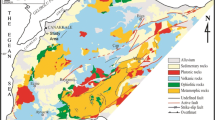Abstract
The application of electrical resistivity tomography (ERT) techniques involving the Wenner and Schlumberger electrode configurations was conducted at the ancient site of Al-Berktain of Jerash, N-Jordan during June, 2011. It may be considered as the first archaeogeophysical survey at this site. The city lived by succession of ancient cultures and still has archaeological remains (e.g. water pools) which gave it historical value and boosted the archaeological interest to make this study. The objective of the work was to determine the layout, dimension, and the depth of expected buried structures (i.e. water channels related to the pool structure) within the site, and to provide recommendations for future excavation projects. The results showed high resistivity anomalies (red color) located within the site. These anomalies were interpreted as a part of a general infrastructure of ancient man-made buried channels or supporting basins draining out or feeding water to the two the water pools especially at the western and eastern sides. Inside the pool (the main structure in the site), results of the survey showed anomalous thin shallow zone interpreted as a layer limestone pavement of a thickness of 1 m. The ERT successfully determined the dimensions of the buried features and proved that this site was water reservoirs to serve the ancient city of Jerash or irrigations purposes beside its use for leisure (i.e. presence of the theatre, roman path and the pools).








Similar content being viewed by others
References
Aspinall A, Gaffney C (2001) The Schlumberger array–potential and pitfalls in archaeological prospection. Archaeol Prospect 8:199–209
Aubin M (1997) Jerash. In: Meyers EM (ed) The oxford encyclopedia of archaeology in the Near East, vol 3. Oxford university press, Oxford and New York, pp 215–219
Browning I (1982) Jerash and the Decapolis. Chatto and Windus Ltd, London
Burdon D (1959) Handbook of the geology of Jordan, to accompany and explain the three sheets of 1:2,50,000 geological map of Jordan east of the rift. Benham, Golchester, pp 36–37
Cardarelli E, Fischanger F (2006) 2D data modeling by electrical resistivity tomography for complex subsurface geology. Geophysical Prospecting 54:121–133
Dahlin T, Loke M, Bernstone C (2002) A3-D resistivity investigation of a contaminated site at Lernacken, Sweden. Geophysics 67:1692–1700
DeDomenico D, Giannino F, Leucci G, Bottari C (2006) Integrated geophysical surveys at the archaeological site of Tindari (Sicily, Italy). J Archaeol Sci 33:961–970
Dey A, Morrison H (1979) Resistivity modeling for arbitrary shaped two dimensional structures. Geophys Prospect 27:1020–1036
Ekinci Y, Kaya M (2007) 3D resistivity imaging of buried tombs at the Parion necropolis (NW Turkey). J Balkan Geophys Soc 10(2):1–8
Eppelbaum L, Khesin B, Itkis S (2009) Archeological geophysics in arid environments: example from Israel. J Arid Environ 74:849–860
Furman A, Ferré T, and Warrick A (2004) Optimization of ERT surveys for monitoring transient hydrological events using perturbation sensitivity and genetic algorithms. VadoseZoneJ.3:1230–1239. Available at http://www.vadosezonejournal.org
Giannino F, Leucci G, Teramo A, and DeDomenico D (2005): Geophysical surveys to improve the knowledge on the S.Salvatore fortress structure (Messina,Italy). Attidel 24°Convegno Nazionale del GNGTS; Roma15, 16e17 Novembre 2005.CD-Rom
Khouri R (1988) Jerash A brief guide to the antiquities. Al Kutba, Amman
Kraeling C (1938) Gerasa: city of the Decapolis. American Schools of Oriental Research, New Haven
Leucci G, Margiotta S, Negri S (2004) Geological and geophysical investigation sinkarstic environment (SaliceSalentino, Lecce, Italy). J Environ Eng Geophys (JEEG) 9:25–34
Loke M (1994). The inversion of two-dimensional apparent resistivity data.unpubl.Ph.D. Thesis, Un.of Birmingham (U.K.)
Loke M (1999) Electrical imaging survey for environmental and engineering studies. Technical notes (http://www.terrajp.co.jp/lokenote.pdf)
Loke M, Barker R (1996) Practical techniques for 3D resistivity surveys and data inversion. Geophys Prospect 44:499–523
Malkawi M (2006) Report on Al Berktain excavation project for 2006
Milson J (2003) Field Geophysics, the Geophysical field guide series, pp 97–10
Oleson J, Gregory S, Baker, Andrew, Sherwood N, Erik de Bruijn M, Barbara Reeves, Heather M, Ambrose Reports on the Humayma excavation project for 2002, 2003, and 2004. Retrieved from World Wide Web: http://web.uvic.ca/~jpoleson/
Qazaq A (1995) The Application of geophysical magnetic method for the investigation of the selected burial at Yasileh archeological site Northern Jordan. M.S. thesis, Yarmouk University, Irbid, Jordan
Reynolds J (1998) An introduction to applied and environmental Geophysics. Wiley, Chichester, pp 418–448
Reynolds J (2005) An introduction to applied and environmental geophysics, 2nd edn. Wiley, Chichester, p 796
Sasaki Y (1992) Resolution of resistivity tomography inferred from numerical simulation. Geophys Prospect 40:453–464
Sharma P (1997) Environmental and engineering geophysics. Cambridge University Press, UK, pp 207–228
Yalçiner C, Bano M, Kadioglu M, Karabacak V, Meghraoui M, Altunel E (2008) New temple discovery at the archaeological site of Nysa (western Turkey) using GPR method. J Archael Sci 36(8):1680–1689
Acknowledgments
Thanks to the Jordanian department of the Antiquities (JoA) for giving permission to survey this archaeological site. Thanks are given to The World Federation of Scientists (WFS) for the partially financial support.
Author information
Authors and Affiliations
Corresponding author
Rights and permissions
About this article
Cite this article
Hawamdeh, A., Jaradat, R. & Alsaad, Z. Integrated application of geophysical methods for investigation of the Al-Berktain archaeological site in the city of Jerash, Jordan. Environ Earth Sci 73, 3665–3674 (2015). https://doi.org/10.1007/s12665-014-3650-6
Received:
Accepted:
Published:
Issue Date:
DOI: https://doi.org/10.1007/s12665-014-3650-6




